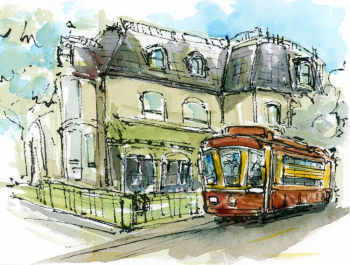11 July 1986
Imagine Wilfrid Laurier stepping out the door of his Sandy Hill home each morning and Canada’s Prime Minister catching a streetcar ride to his office on Parliament Hill every day.
One Ottawa columnist asserted that “Sir Wilfrid’s democratic principles will not allow his riding in anything aught else but trams”. It was said that Laurier relied on his daily conversations with his fellow streetcar riders to keep him in touch with views of everyday Canadians.
(Many thanks to Ottawa artist Tommy Lee for creating this beautiful watercolour and ink rendering, especially for this post, depicting a Ottawa Electric Railway (OER) streetcar pulling up in front of Sir Wilfrid’s house.)
Wilfrid Laurier lived at 335 Theodore St., today 335 Laurier Avene and maintained as a national historic site as “Laurier House”, having been home over time to two Canadian Prime Ministers, Laurier and Mackenzie King, for more than half a century.
In contrast to Canada’s first Prime Minister, John A Macdonald, Laurier was not a wealthy man and had lacked the financial resources to purchase a home befitting a nation’s leader.
As a result, upon Laurier’s election as Prime Minister on July 11, 1896, Laurier’s friends and political supporters pooled together to buy Sir Wilfrid this now-famous yellow brick residence, formerly built as the home of a Sparks St. jeweler. Interestingly, one of those generous financial donors was renowned entrepreneur Thomas Ahearn, a founder and owner of the Ottawa Electric Railway, having just recently launched Ottawa’s first-ever system of electric streetcars. Also, conveniently, one of the new OER’s streetcar lines ended up running right down Theodore St., right in front of Laurier’s new home, with a stop directly opposite his front door.
For the next two decades, and the rest of his life, Laurier remained a famously faithful patron to the OER streetcar system. In fact, when Laurier suffered a stroke working alone in his office on February 15, 1919, Sir Wilfrid rode the streetcar back to home and died two days later. Streetcar usage began to decline in the 1920s and the last of Ottawa’s streetcars came to a stop in 1959. Today there is an OC Transpo bus stop directly in front of Laurier House, with the route name “Parliament” fittingly emblazoned on the sign.
Laurier was not the only Prime Minister to use commonplace means to transport themselves to work. Sir Robert Borden was known to ride his bicycle to work from his home on Lowertown’s Wurtemburg Street. Macdonald liked to walk to Parliament Hill when he lived on Besserer Street. in Sandy Hill and once asked for a precise measurement of his route so he could know how far he walked every day. Jean Chretien preferred a motorized commute to work but, when spotting a tour bus on the way home along Sussex Drive, was known to have his driver pull over to allow the PM to hop aboard and spend a few moments mingling with the out-of-towners.
After Laurier’s death in 1919, his widow Zoé gifted the house to the next Liberal leader, Mackenzie King. Upon his death in 1950, King bequeathed Laurier House to the people of Canada to be preserved as a national historic site. Subsequently, the decision was made that Canada should finally purchase an official residence for its Prime Ministers. In 1951, King’s successor, Louis St. Laurent, (grudgingly) moved into 24 Sussex.
Follow this link if you would like to view more of Tommy Lee's artwork: www.facebook.com/tommyleeartsnow
For more fascinating Sandy Hill history, visit this excellent webpage created by the late François Bregha: www.ash-acs.ca/history
Story written by Ben Weiss. Ben has been part of the HSO communication team for a number of years, managing our Facebook page as well as regular email communications to our members. Ben was coordinator and host for our Speaker Series for several years, is a past recipient of the HSO François Bregha Storytellers’ Award, and continues to serve as an advisor for various projects and committees.






